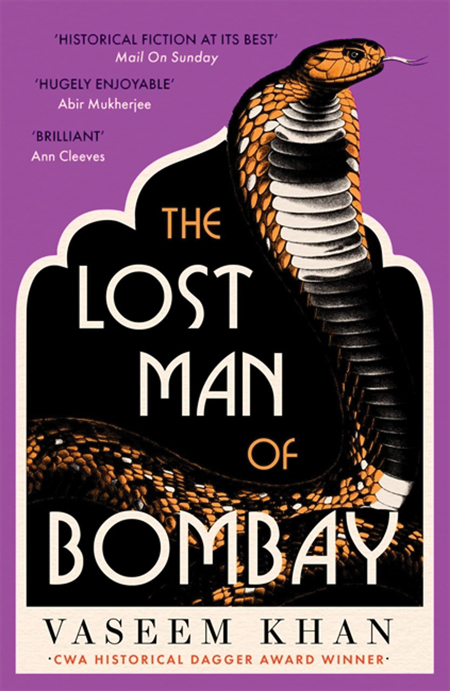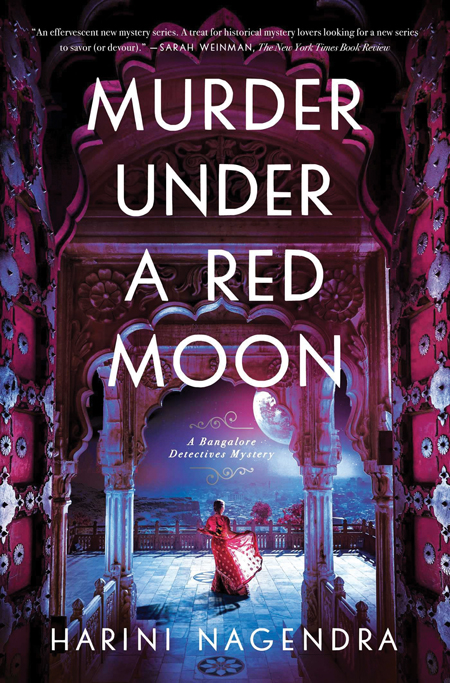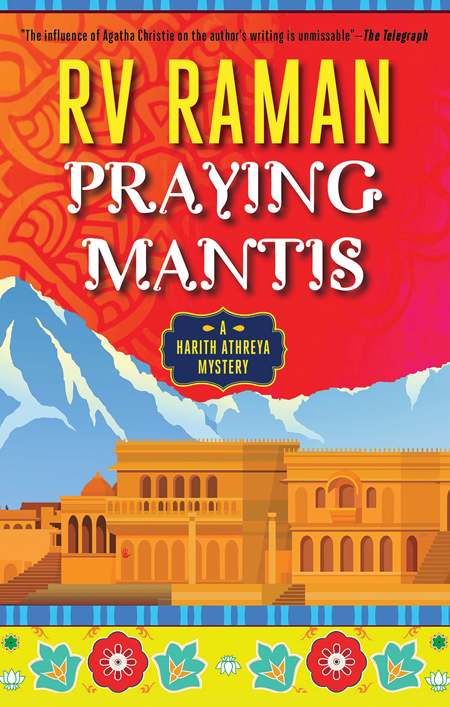Mystery Matters: How They Do Their Whodunits

BHARTI KIRCHNER established herself as an author of literary fiction and cookbooks before she transitioned to mystery novels. Here, adopting the roles of a reporter and a detective, she interviews three fellow novelists—Vaseem Khan, Harini Nagendra, and R.V. Raman—to learn their plotting strategy, writing secrets, and recipe for success.
In comparing notes with fellow South Asians, I’ve found that most of us grew up listening to stories. Family tales, of course. But for those raised in India, like me, the Ramayana and Mahabharata counted as well. Later, as we started to form our own reading lists, we discovered Sir Conan Doyle and Agatha Christie, among other Western authors. Never mind the fact that these books were set in faraway locations, such as England and Egypt, our childhood imaginations only received more fuel from them.
This might be one reason why some of us who later became writers took up mystery writing. A reader might ask: What makes writers gravitate toward the mystery genre? How do they select a plot? The three top mystery writers I interviewed have an India connection.
Why are you drawn to the mystery genre?
Says U.K.-based Vaseem Khan, author of two award-winning crime series set in India: “I love mystery and crime writing because it allows us to comment on the world around us, but to do so in an entertaining package. My Malabar House novels explore India in the 1950s, just after Gandhi’s assassination, the horrors of Partition, and Indian independence. Midnight at Malabar House introduces us to India’s first female policewoman, investigating the murder of a top English diplomat in Bombay. The book allows me to explore issues such as colonialism and misogyny.”
R.V. Raman, based in India and writing about crime, fantasy, and speculative science, speaks about his early reading habits. “For as long as I can remember,” he says, “we’ve had books by Conan Doyle, Christie, and Wodehouse at home. As a schoolboy, once I had run through the Enid Blyton range, I turned to these authors. While Wodehouse was difficult to appreciate at that age, the others were not. My parents and my sisters encouraged me as I made acquaintance with Sherlock Holmes and Watson. Within a few weeks, I had exhausted the 56 stories and I picked up Christie’s A Mysterious Affair at Styles. Once again, I was fascinated, this time with Poirot and the puzzles Christie served up.”
“I’ve always loved reading mysteries,” says the author Harini Nagendra, an ecologist in India. “It probably dates back to when I was about six or seven years old, obsessed with Enid Blyton. I love learning about a new place, time, or historical event through a mystery book. And I especially love series—where I learn more about the characters as they grow, engage with each other, find new friends (and enemies) and take on new responsibilities such as parenting or elder care as they age. Mysteries are a mirror to life, and that early childhood fascination of mine has only continued to grow over time.”


[Top] U.K.-based Vaseem Khan wanted to explore issues such as colonialism and misogyny in his fiction.
What was the inspiration/motivation in writing your first mystery novel? How did you come up with the plotline?
“By the time I had crossed 50 and was preparing to slow down professionally,” says Raman, “I had read many, many mysteries, especially of the Golden Age. But there was a problem: not one of them was set in India. I wanted to remedy that if I could. I had just finished writing four ‘corporate thrillers’ that dealt with white-collar crime and murder in corporate India. I had a newfound confidence to attempt a traditional mystery, titled A Will to Kill.
“For the setting, I picked a Golden Age favorite: a remote country manor. I set my manor in the hills of South India (the Nilgiris) and filled it with relatives awaiting their inheritance from a strong-willed, but wheelchair-bound, man. I added two conflicting wills, inserted a backstory, and threw in a ghostly angle.”
Nagendra recalls a specific incident. “The year was 2007. I was in my mother’s house, surrounded by a pile of archival documents, while conducting research on historical Bangalore—as part of my ‘day job’ as an ecologist. My main protagonist—19-year-old Kaveri—parachuted into my head, with a very clear and defined (and spunky!) personality, demanding that I write a book about her. It took me 13 years to complete Book 1 in the series, partly because I was learning how to find my own path to get from the start to the finish line. I rewrote the plotline three times but found the entire experience very useful—it helped me learn what way of writing suits me best.”
Khan exemplifies the difficulty some mystery authors experience in getting published by saying, “I actually wrote my first mystery novel after 23 years and seven books that were not published. I was finally published with my first series, which began with The Unexpected Inheritance of Inspector Chopra, about an Indian policeman in modern Mumbai who is forced into early retirement, and must solve a murder, all while looking after a baby elephant. The book was voted by the Sunday Times as one of the 40 best crime novels 2015-2020 and translated around the world. That book was inspired by the 10 years I lived in India and my desire to showcase the changing country that I saw around me, to depict the light and dark of the subcontinent.”


[Top] Harini Nagendra, an ecologist and author in Bangalore, sees mysteries as a mirror of life.
Please comment on the importance of the place or setting in your novel. Why this specific location?
“In recent years, there have been a number of excellent historical mysteries set in India,” says Nagendra, “but these are largely in north Indian megacities—Bombay, Calcutta, and Delhi. I love Bangalore—not only is it my favorite city, but also a place which I am very familiar with, having studied its ecological history in detail for close to 18 years as part of my academic research. So, it was very natural for me to set my books in Bangalore, thereby introducing readers to a new setting and a different part of the world that many may be less familiar with.
“In terms of the period, The Bangalore Detective Club series is located in 1920s Bangalore, during the colonial British era. The 1920s is the classic Golden Age, when the horrors of World War I have just begun to fade from memory, and women are beginning to step out of the house, study, work, take on new roles and responsibilities—while still navigating societal expectations. This allowed me to explore women’s issues in greater depth, and to investigate the growing calls for India’s independence.”
India—past and present—is also in the mind of Khan. “Books are the best way to travel the world,” he says. “My aim is to take readers on a journey to India, be it modern India with my first series (the Baby Ganesh Agency novels) or historical India with my current series—the Malabar House novels, which I use to examine how modern India came to be. My novels are motivated by the 300 years that the British were in India. They allow me to talk about identity, colonialism, Anglo-Indian relations, and the complex, messy process of India finding her feet after independence. My hope is that we can unpick history and learn from it.”
Raman, too, emphasizes the importance of the setting in his writing. “It’s one of the critical elements of a story,” he says. “It gives character and body. Each book in my Athreya series takes the reader to a different setting in India. While the first is set in the Nigiris, the second is in the hinterland of Bundelkhand. The third will take you to the Himalayas and the fourth to the backwaters of Kerala. During my childhood, Western authors had taken me to places I had not visited then—London, New York, Baghdad, Japan, etc. I would now like to return the favor.”
If you’re writing a series, what sustains your series?
“The Athreya series is my third series,” says Raman. “I’ve also written a fantasy series as Kevan Dinn. I see three elements that sustain each of them: the characters, the fictional world, and an underlying theme. The characters sometimes develop in ways that I do not anticipate. It’s as if they acquire minds of their own. Same is the case with the world—you discover new things all the time. And finally, the consummation of a theme takes multiple stories. Unfortunately, commercial as well as editorial considerations sometimes limit the exploration of these three elements.”
Nagendra announces the soon-to-be released Book Two, titled Murder Under a Red Moon, in the Bangalore Detectives Club series. “Characters and setting are most critical for me,” she says, “as well as the issues I tackle. These primarily revolve around three axes—women’s empowerment, India’s fight for independence, and the sisterhood of women from very different backgrounds. As the series grows, each character is really coming into their own, revealing aspects of their personality that I find fascinating. As long as I continue to have as much fun as I am right now, the series will keep running.”
Khan speaks about his two on-going series and why his readers love them. “Both of them are about people with integrity operating in environments where political turbulence, corruption, and societal fault lines make navigating the straight path difficult. In my latest book, The Lost Man of Bombay, the third in the Malabar House series, a dead white man is found in the Himalayan foothills with only a notebook containing cryptic clues. As Persis investigates, she encounters intense political opposition and must navigate a particularly dark time in India’s past. It’s this mix of history and mystery that seems to keep my readers coming back for more.”


[Top] Indian settings are crucial for R.V. Raman, a management professor who avoids profanity and sleaze in his mysteries.
How are you different from Western mystery writers (if you are)?
“I don’t know if I am very different,” says Nagendra. “But the characters I write about are very different from the characters you would find in a Miss Marple novel by Agatha Christie, or a Miss Silver book by Patricia Wentworth. From Kaveri’s husband Ramu, who is incredibly supportive of her, to her acerbic mother-in-law Bhargavi, and their delivery boy Venu, all the characters in the book are very much a product of the time and place they inhabit. When readers close the book, I want them to leave with the aroma of Bangalore filling their senses—the rain trees that shade the sunny streets, the keening of the kite that flies high above the lakes, the monkeys that grab the coconuts from the trees swaying in the skyline. Certainly, these are ingredients not to be found in any Western mystery.”
Raman insists that he’s not that different. “I set my stories in my country, just as they set theirs in the West. However, I do believe that the environment in which I write is different from theirs. Publishing is a difficult business in India. Crime fiction is especially hard to sell—both for the writer and the publisher. While I may not be any different from Western writers, I think I am different from most contemporary writers in that I eschew profanity and sleaze. I prefer to read and write clean stories.”
Khan’s books are often compared in style to those of Agatha Christie. “This is because they embody a Golden Age sensibility and because they are tightly plotted, intellectually challenging mysteries,” he says. “But I also bring a dual perspective to my subject matter. Being born in the U.K. but having subcontinental heritage and having lived in India I can interrogate history through a different prism. For instance, The Dying Day, the second in my Malabar House series, sees the theft of a priceless copy of Dante’s The Divine Comedy from Bombay’s Asiatic Society with only cryptic clues written in verse left behind, and a few bodies. Using my dual ‘heritage’ allows me to create plots that appeal to audiences around the world.”
Bharti Kirchner is the author of nine novels. Her latest title, Murder at Jaipur: A Maya Mallick Mystery, is due out this year.
Enjoyed reading Khabar magazine? Subscribe to Khabar and get a full digital copy of this Indian-American community magazine.
blog comments powered by Disqus










